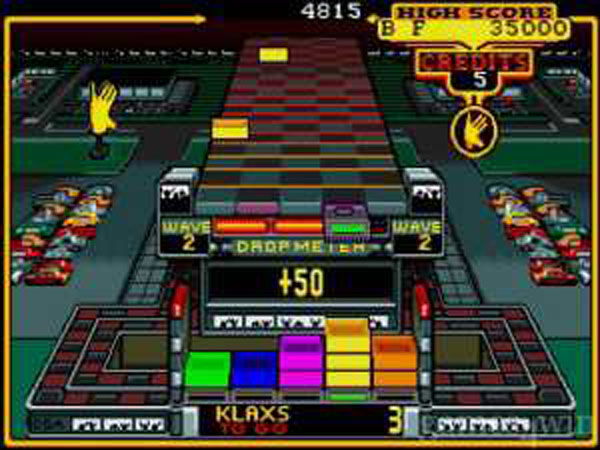

 |

|
 |
Klax (video Game)Akers programmed Klax in just a few weeks using AmigaBASIC, then ported it line-by-line to C. In a 1990 interview, he said he wanted to "produce something playable, compact and relatively quick to develop." His influences were both Tetris and tic-tac-toe. He chose the name from the sound tiles make rolling across the screen.
The prototype game ran on the same hardware as Escape from the Planet of the Robot Monsters.
Atari Games released Klax in February 1990, and soon called it a "major arcade hit". They quickly released several home versions under the Tengen brand. Akers created the Nintendo Entertainment System and Mega Drive/Genesis editions himself. Some 16-bit conversions featured improved graphics.
Klax received the Parents' Choice Foundation's seal of approval in 1990, won Best Mind Game at the 1991 European Computer Leisure Awards, and Dennis Lynch of the Chicago Tribune named it the Best Cartridge of 1990.
Midway Games gained the rights to Klax upon purchasing Atari Games in 1996. The title has been re-released in retro compilations for modern consoles. A 1999 press release called it Midway's "tic-tac tile puzzle game."
Klax's catchphrase, "It is the nineties and there is time for Klax", appears during the game's attract mode. The Game Boy Color version of the game, released in 1999, changed "nineties" to "millennium". Later versions, such as the 2005 Game Boy Advance version, change "nineties" to "modern days".
Mike Mika, who was working on the Game Boy Color version of the game, placed a hidden wedding proposal inside it. It took his then girlfriend three years to uncover the proposal. Mike Mika also placed a hidden Snake-like game as well as a mini adventure game within the game as easter eggs. Klax (video Game) GameplayKlax features a conveyor belt at the top of the screen. It constantly rolls toward the playing area, delivering a steady supply of blocks. The player controls a small device which sits at the interface between the conveyor belt and the playing area, and can be moved left and right to catch the blocks and either deposit them in the playing area (which can hold 25 blocks in a 5X5 arrangement) or push them back up the conveyor belt. The device can hold up to five blocks. A block which is not caught and placed in the playing area or pushed back up the belt is considered a drop. The blocks are solid colours, but there is also a flashing block which can be used as a wildcard on any colour.
Klax consists of 100 levels grouped into blocks of five. At the beginning of the game and after each fifth level (levels divisible by five, except for Levels 95 and 100), a player can choose to skip five or ten levels. Skipping levels gives bonus points and more drops (three drops are the standard if no levels are skipped, four drops are allowed if five levels are skipped, and five drops are allowed if ten levels are skipped).
In the playing area, blocks can be eliminated by arranging three or more of the same color into a continuous line, known as a "Klax." The line may be horizontal, vertical, or diagonal. A multiple grouping (e.g., one vertical and horizontal) counts as multiple Klaxes, as does Klaxes of four same-colored blocks (two Klaxes) or five same-colored blocks (three Klaxes). Once the goal is reached, bonus points are awarded for remaining blocks on the conveyor belt and device, and empty spaces in the bin (also, on levels where a certain point total is required, points in excess of the required amount are counted both in the scoring and as bonus points).
In Levels 6 and 11, the player can warp ahead 45 levels by building a large X with five blocks for each diagonal. Doing so awards a 600,000 point bonus for Level 6 and 700,000 for Level 11 in lieu of the standard skipping bonus (however, any empty bin or remaining blocks bonuses are awarded).
There are 100 levels in Klax, and a score of 250,000 is required to complete the last level. (The unreleased Atari 7800 version added three "impossible" levels.)
The game ends when:
The player exceeds the allowable number of drops (the drops are cumulative through a series of five levels, or six when a warp is successful, but are reset to zero once the last level in the series is successfully completed) The player fills the entire playing area with blocks and cannot complete any Klaxes Or the player successfully completes Level 100.
|
CAN'T FIND WHAT YOU'RE LOOKING FOR? CLICK HERE!!!